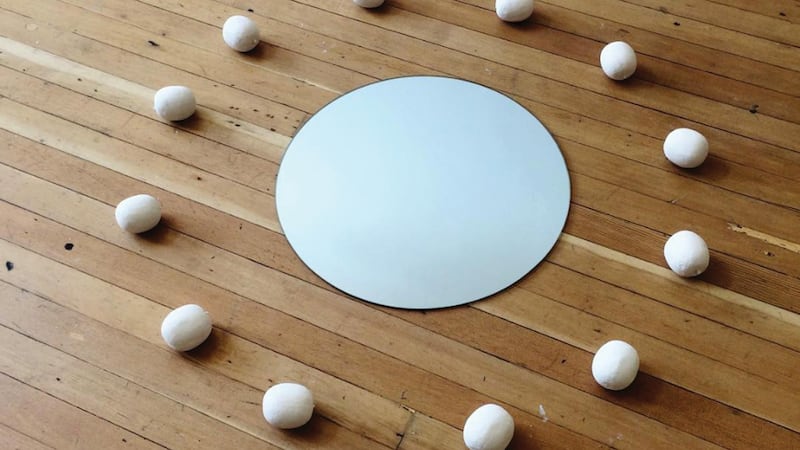At first, PNCA's I pass unto you looks airy and serene, even plain. In Angela Saenz and Madeleine Barbier's collaborative exhibit, pages of text are displayed under Plexiglass on podiums. A few untreated and unstretched sheets of canvas with black and white sketches hang on a wall. Most intriguingly, a circular mirror lies in the center of the floor, surrounded by a ring of white plaster lemons.
But when you look closer, things start to get weird. Saenz's video installation The Earth won't die. Humanity will die, and the ocean will rise higher. plays in a small, dark room off the main exhibit space. With jerky graphics reminiscent of Monty Python, the video depicts a world consumed by a flood. The banal moments are the ones that seem the most foreboding. In one, we're looking at clothes drying in a corner of an apartment. Draped over a ladder, they flap in the breeze of a white table fan. The video cuts to the back of a woman looking out her window, her head propped on her hand.
Then, we see the water. It looks like blue crayon scribbles rising in front of the window. The woman grabs the back of her neck with her hand. She stands up abruptly. The scene cuts back to the clothes, and an impressionist painting of a coastline rises from the bottom of the screen until it blocks the apartment entirely.
Barbier's work, on the other hand, builds narrative out of nonsense. Her static pieces are mostly text—pages that look like they're cut from a nonexistent book and displayed around the gallery. They tell a story of a girl name Holly, but what that story is or who Holly is seems intentionally unclear. The most coherent scene is of Holly going to a market, where she has a spiritual exchange with a merchant who gives her a dress "the texture of a princess's matted hair." The pages don't seem to be displayed according to any recognizable chronology or plot. They reference characters and events that can't be found elsewhere in the exhibit: "Holly and the spider-wraith are really the same person."
The writing is almost humorously oblique: "Holly becomes the spider-wraith after first losing her beloved moon-horse, which of course happens after she finds all 12 tsunami stones." But instead of seeming like total nonsense, the disconnected episodes feel like fragments from an epic.
On one of Barbier's pages, there's a diagram of "tsunami stones." It matches the layout of Saenz's floor installation of a mirror surrounded by plaster lemons, Forbidden fruit are found among stones and groups of twelve. The connection between the artists' works doesn't seem any easier to pinpoint than it is to understand what a dream horse is, but it feels like a bridge between two worlds: one that's dying, and another that seems to exist out of time.
SEE IT: I pass unto you is at PNCA, 511 NW Broadway, pnca.edu. Runs through Sept. 1.
